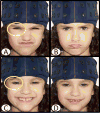Using facial muscular movements to understand young children's emotion regulation and concurrent neural activation
- PMID: 29226482
- PMCID: PMC5995650
- DOI: 10.1111/desc.12628
Using facial muscular movements to understand young children's emotion regulation and concurrent neural activation
Abstract
Individual differences in young children's frustration responses set the stage for myriad developmental outcomes and represent an area of intense empirical interest. Emotion regulation is hypothesized to comprise the interplay of complex behaviors, such as facial expressions, and activation of concurrent underlying neural systems. At present, however, the literature has mostly examined children's observed emotion regulation behaviors and assumed underlying brain activation through separate investigations, resulting in theoretical gaps in our understanding of how children regulate emotion in vivo. Our goal was to elucidate links between young children's emotion regulation-related neural activation, facial muscular movements, and parent-rated temperamental emotion regulation. Sixty-five children (age 3-7) completed a frustration-inducing computer task while lateral prefrontal cortex (LPFC) activation and concurrent facial expressions were recorded. Negative facial expressions with eye constriction were inversely associated with both parent-rated temperamental emotion regulation and concurrent LPFC activation. Moreover, we found evidence that positive expressions with eye constriction during frustration may be associated with stronger LPFC activation. Results suggest a correspondence between facial expressions and LPFC activation that may explicate how children regulate emotion in real time.
© 2017 John Wiley & Sons Ltd.
Conflict of interest statement
Drs. Grabell, Barker, Huppert, and Perlman, and Ms. Li, Jones, Wilett, and Bemis report no competing interests.
Figures




References
-
- Abler B, Walter H, Erk S. Neural correlates of frustration. Neuroreport. 2005;16(7):669–672. - PubMed
-
- Adleman NE, Menon V, Blasey CM, White CD, Warsofsky IS, Glover GH, Reiss AL. A developmental fMRI study of the Stroop color-word task. Neuroimage. 2002;16(1):61–75. - PubMed
-
- Benjamini Y, Hochberg Y. Controlling the false discovery rate: a practical and powerful approach to multiple testing. Journal of the Royal Statistical Society Series B (Methodological) 1995:289–300.
Publication types
MeSH terms
Grants and funding
LinkOut - more resources
Full Text Sources
Other Literature Sources

